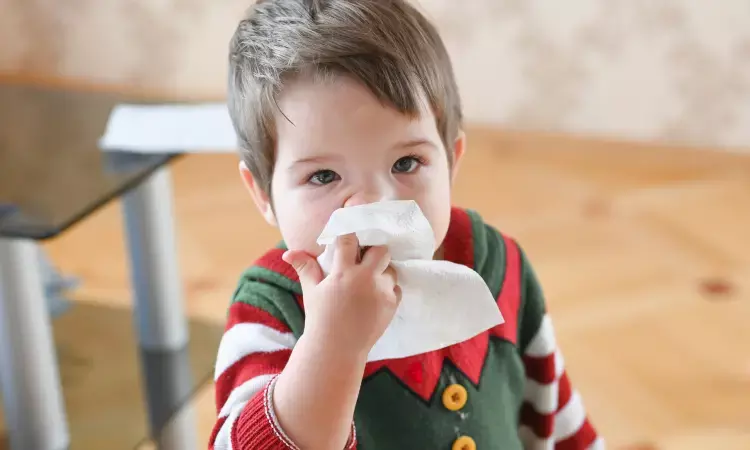- Home
- Medical news & Guidelines
- Anesthesiology
- Cardiology and CTVS
- Critical Care
- Dentistry
- Dermatology
- Diabetes and Endocrinology
- ENT
- Gastroenterology
- Medicine
- Nephrology
- Neurology
- Obstretics-Gynaecology
- Oncology
- Ophthalmology
- Orthopaedics
- Pediatrics-Neonatology
- Psychiatry
- Pulmonology
- Radiology
- Surgery
- Urology
- Laboratory Medicine
- Diet
- Nursing
- Paramedical
- Physiotherapy
- Health news
- Fact Check
- Bone Health Fact Check
- Brain Health Fact Check
- Cancer Related Fact Check
- Child Care Fact Check
- Dental and oral health fact check
- Diabetes and metabolic health fact check
- Diet and Nutrition Fact Check
- Eye and ENT Care Fact Check
- Fitness fact check
- Gut health fact check
- Heart health fact check
- Kidney health fact check
- Medical education fact check
- Men's health fact check
- Respiratory fact check
- Skin and hair care fact check
- Vaccine and Immunization fact check
- Women's health fact check
- AYUSH
- State News
- Andaman and Nicobar Islands
- Andhra Pradesh
- Arunachal Pradesh
- Assam
- Bihar
- Chandigarh
- Chattisgarh
- Dadra and Nagar Haveli
- Daman and Diu
- Delhi
- Goa
- Gujarat
- Haryana
- Himachal Pradesh
- Jammu & Kashmir
- Jharkhand
- Karnataka
- Kerala
- Ladakh
- Lakshadweep
- Madhya Pradesh
- Maharashtra
- Manipur
- Meghalaya
- Mizoram
- Nagaland
- Odisha
- Puducherry
- Punjab
- Rajasthan
- Sikkim
- Tamil Nadu
- Telangana
- Tripura
- Uttar Pradesh
- Uttrakhand
- West Bengal
- Medical Education
- Industry
Nasal eosinophilia and responsiveness to local steroids hallmark of non-allergic rhinitis

Greece: A recent study published in the European Archives of Oto-Rhino-Laryngology has concluded that the presence of nasal Eosinophils > 20% and continuous response to nasal steroid therapy indicates Atopia in children with Non-Allergic Rhinitis (NAR) symptoms. The researchers added that nasal eosinophilia is a biomarker of NAR and is suggestive of further investigation, such as NAPT, to distinguish Local Allergic Rhinitis (LAR) from non-allergic rhinitis with eosinophilia syndrome (NARES).
NAR in children, named local allergic rhinitis (LAR) and non-allergic rhinitis with eosinophilia syndrome (NARES), is characterized by symptoms suggestive of allergic rhinitis in the absence of systemic atopy. The principal cells involved in allergy inflammation are Nasal eosinophils (nEo). The standard diagnostic method is the nasal allergen provocation test, but it has limitations. There is a need to distinguish NAR from NARES.
Considering this, a study was conducted by Athina Papadopoulou from the Pediatric Allergy and Asthma Unit at KAT General Hospital to determine if nEo and therapeutic response to nasal steroids combination could be validated or not to preliminary distinguish NAR from NARES in real-life data.
The key points of the study are:
• The study enrolled 128 children, including 63.3% of males with a NAR history.
• The participants were followed up for 52 ± 32 m.
• Nasal cytology was performed at baseline to non-atopic children.
• The symptoms of allergic rhinitis were present for more than eight weeks.
• The nasal steroids were given for 20 days.
• 10-VAS clinically evaluated response to therapy.
• In relapsing symptoms and nEo, the same therapeutics was repeated.
• During the follow-up period, those cases which were constantly responding to nasal steroids proceeded for NAPT intending to distinguish LAR from NARES.
• Significant nasal Eosinophils were reported in 59.3% of the cases, and there was an association with reported dyspnea episodes.
• 23.4% did not respond to therapy.
• 51.5% of children constantly responded to treatment.
• Response to therapy was related to nasal eosinophils.
• The cut-off point was 20%.
Researchers reported nasal eosinophils as the most reliable biological marker and had a sensitivity of 94 % and specificity of 77 %.
The co-researcher, Stavroula Lambidi from the Pediatric Allergy and Asthma Unit at KAT General Hospital, said nasal eosinophilia > 20% constantly responding to nasal steroid therapy in children with symptoms of NAR indicates atopy.
In everyday clinical practice, this is an easy, preliminary cell biomarker and suggests further investigation for NAPT, and it also discriminates LAR from NARES.
Further reading:
Papadopoulou, A., Lambidi, S., Lagousi, T. et al. Nasal eosinophilia as a preliminary discriminative biomarker of non-allergic rhinitis in everyday clinical pediatric practice. Eur Arch Otorhinolaryngol (2022). https://doi.org/10.1007/s00405-022-07704-0
BDS, MDS in Periodontics and Implantology
Dr. Aditi Yadav is a BDS, MDS in Periodontics and Implantology. She has a clinical experience of 5 years as a laser dental surgeon. She also has a Diploma in clinical research and pharmacovigilance and is a Certified data scientist. She is currently working as a content developer in e-health services. Dr. Yadav has a keen interest in Medical Journalism and is actively involved in Medical Research writing.
Dr Kamal Kant Kohli-MBBS, DTCD- a chest specialist with more than 30 years of practice and a flair for writing clinical articles, Dr Kamal Kant Kohli joined Medical Dialogues as a Chief Editor of Medical News. Besides writing articles, as an editor, he proofreads and verifies all the medical content published on Medical Dialogues including those coming from journals, studies,medical conferences,guidelines etc. Email: drkohli@medicaldialogues.in. Contact no. 011-43720751


